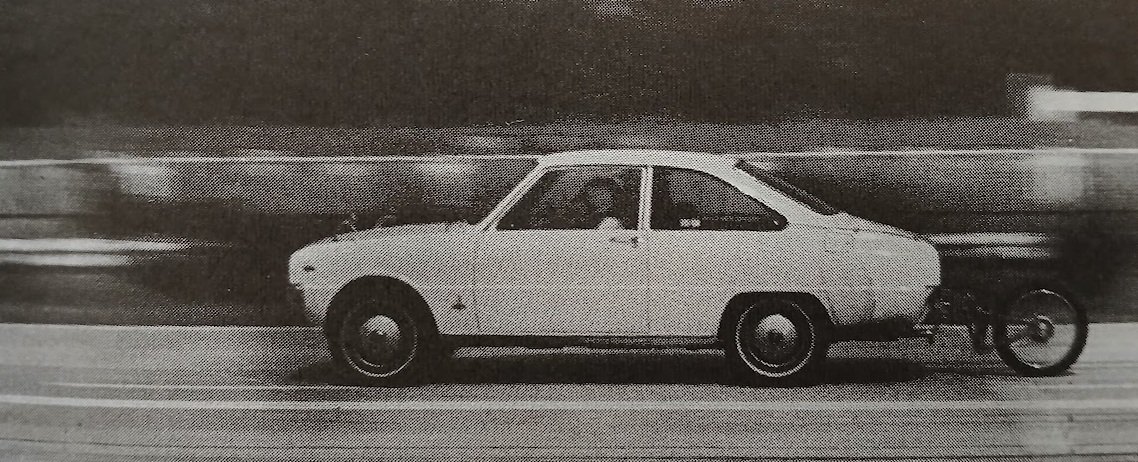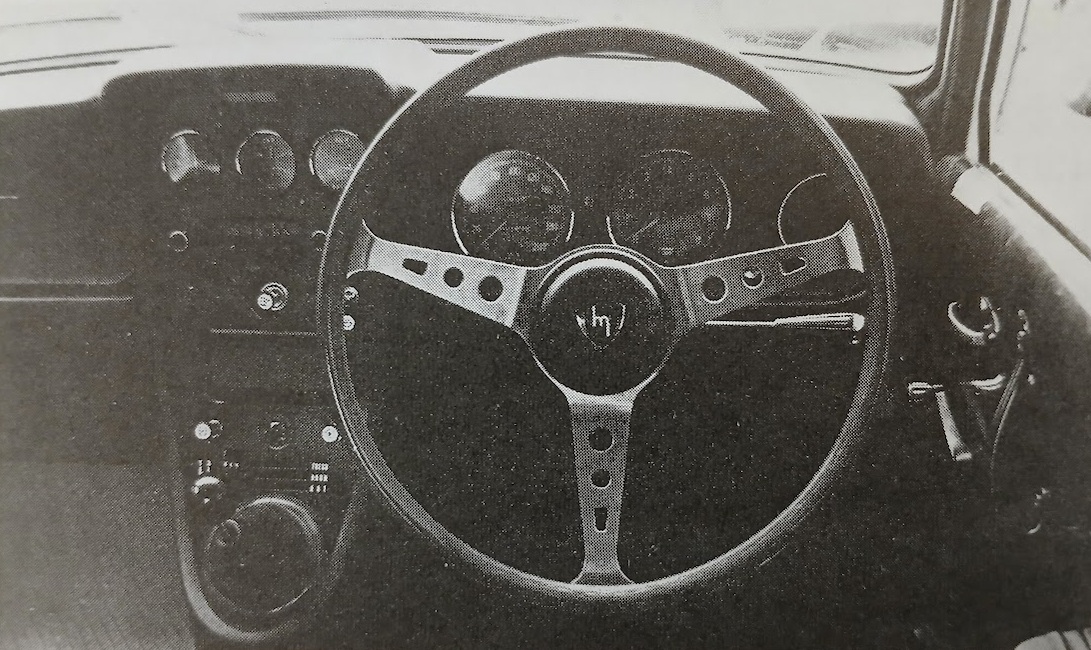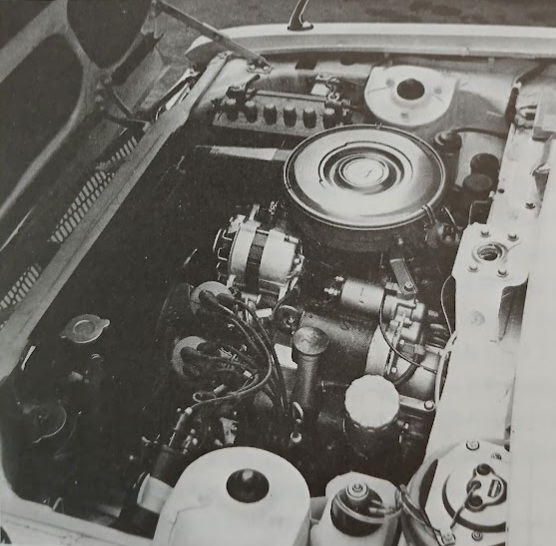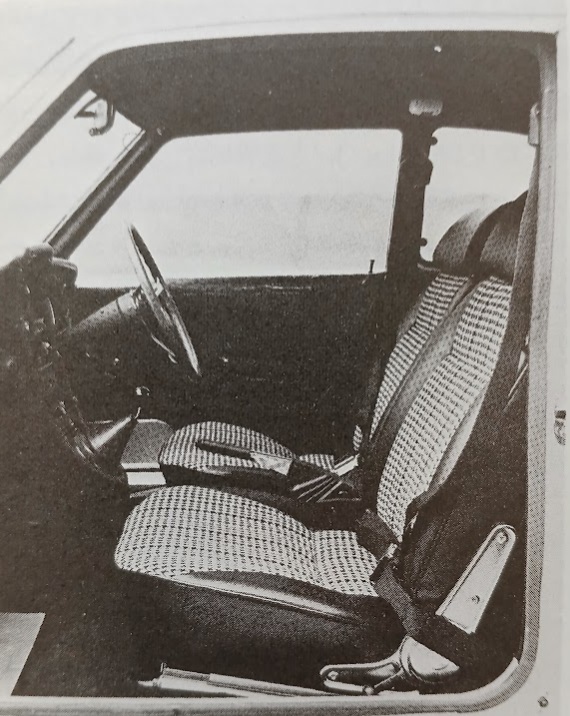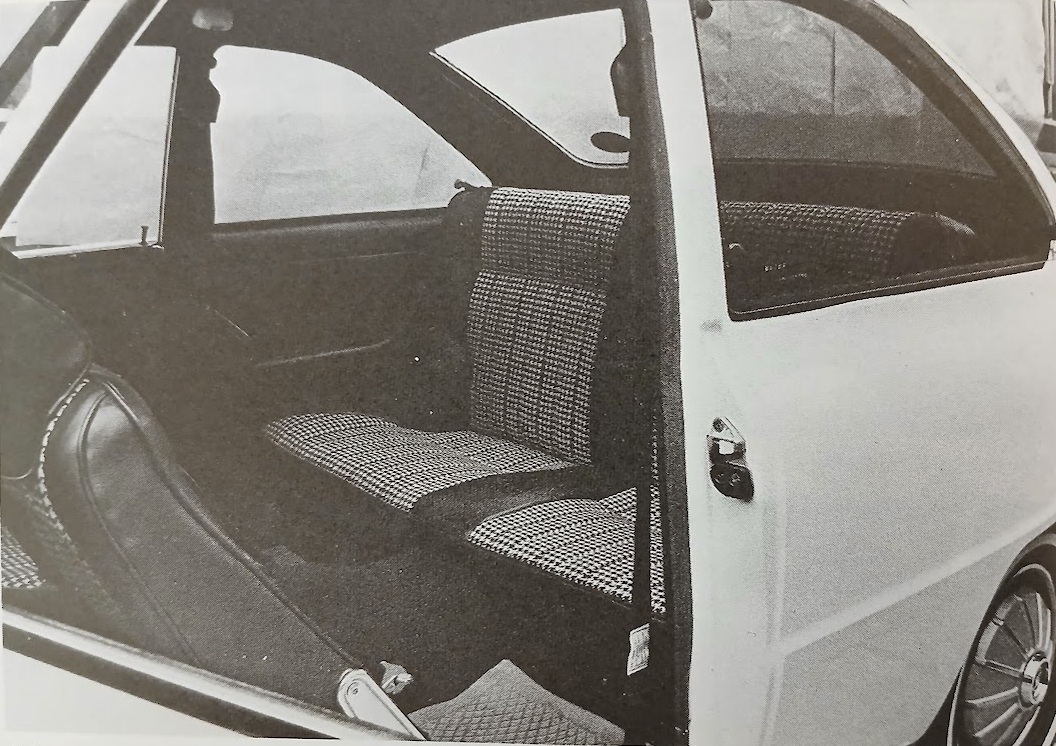Mazda Familia Rotary Coupe (1968)
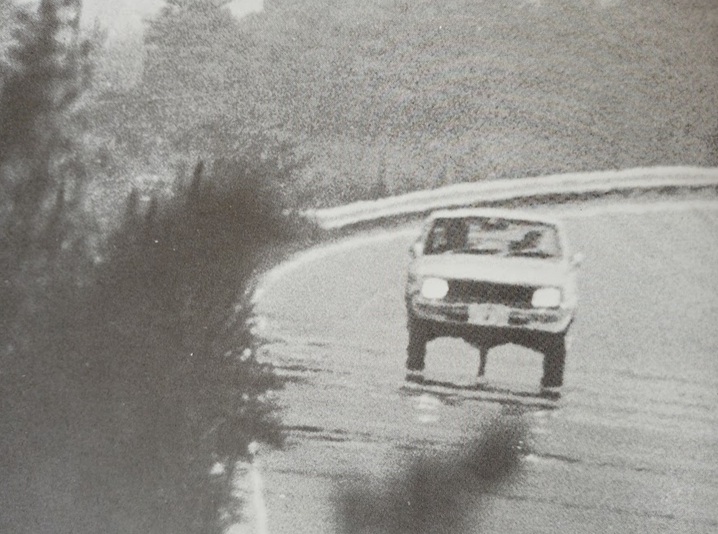
Publication: Car Graphic
Format: Road Test
Date: September 1968
Author: “C/G Test Group” (uncredited)
Summary:Car Graphic purchased the Mazda Familia Rotary Coupe as soon as it was released, and immediately began our customary long-term practical testing. Our magazine has already purchased the Toyota Corolla, Bluebird 1300, Lotus Europa, and Nissan Laurel one after the other, and is conducting controlled tests from a strictly objective standpoint while also putting them to use in daily life. The Familia Rotary Coupe is our fifth attempt to evaluate a new model through this method of long-term practical testing.
Road testing the Familia Rotary Coupe
Our conclusion after testing the Familia Rotary Coupe for about 2,000km is that, as far as power performance is concerned, it can be summed up in one word: “exceptional.” On the 5.5km test course at Yatabe, our test car recorded a maximum speed of 184.0km/h (measured by fifth wheel speedometer), an average speed of 179.7km/h over the 400m section (measured by photocell), a 0-400m time of 17.2 seconds, and a time to 160km/h of 33.4 seconds, which is almost as fast as the standard Lotus Elan. Moreover, while the Lotus is a pure two-seater sports car, the Rotary Coupe is a completely practical five-seat (at least legally) coupe, and above all, it is a low-priced car at 700,000 yen.
The key to this amazing performance is, of course, the NSU-Wankel patented twin-rotor rotary engine, which is basically the same as the Cosmo’s 491cc x 2 engine (L10B type) of which 340 have been sold since last June, but it has been slightly detuned and redesigned to better suit a mass-market vehicle. Power is 100ps/7000rpm compared to the Cosmo’s 128ps/7000rpm, and torque is 13.5kgm/3500rpm compared to the Cosmo’s 14.2kgm/5000rpm. However, the Familia Rotary Coupe weighs only 805kg, 150kg less than the Cosmo, so there is almost no difference in power-to-weight ratio.
The Cosmo engine is already known for its smoothness and flexibility, but the new Rotary Coupe’s 100ps engine feels even more so. On cold mornings, it literally starts with a flick of the starter, and even if you immediately take your foot off the throttle, it continues to rotate smoothly at 600-700rpm (this is the rotation speed of the output shaft, and the rotor itself rotates at the same speed). Even when you first pull out onto the road after a brief warm-up, it responds immediately to the throttle and accelerates powerfully.
The rev counter shows the yellow zone marked from 6500-7000rpm, and the red zone is 7000-8000rpm. The rotary engine has no valve gear to crash, and the intake and exhaust system is highly efficient, so the only thing to stop it from over-revving is the driver’s own self-control. After the test, we read the owner’s manual carefully and it said that if the engine exceeds 7100rpm, plus or minus 200rpm, a buzzer goes off and there is a safety device that automatically cuts off the secondary fuel supply, but this (fortunately?) was not working on our test car.
The rotary’s smooth revving and good balancing can be compared to that of a well-tuned two-stroke engine. Two-strokes tend to be rough at low revs and have a narrow effective power band, but the Mazda rotary engine is surprisingly flexible when lugged down to low speeds and exerts strong torque over a very wide range. When you first get into this car, you’ll be tempted to drive it only at high revs and in low gears, partly out of curiosity and partly because of the engine’s light-revving nature. But once the initial excitement has died down and you’ve regained your composure, you’ll notice that it is usable at lower revs than you’d expect. In fact, because of the ample power, you can start gently from 1000rpm once you get used to it, and according to the manual, for the first 1,000km of running in, you should actually keep the rotation below 3000rpm. Regardless of how frustrating that felt psychologically, in practical terms it was not at all inconvenient. Acceleration is exceptionally good, and even if you limit your upshift point to 3000rpm, by the time you shift into third gear, you’ll have left most other traffic behind. On the day we bought the C/G Rotary Coupe, we took it to and from the FISCO circuit to do some running-in, and we didn’t feel any inconvenience, as it could reach about 90km/h at 3000rpm even on the Tomei Expressway.
The Rotary Coupe is a very easy car to drive in the city. With its large reserve of horsepower, even beginners will find it very easy to drive. Despite the rotary engine’s technical novelty, no special techniques are required. As mentioned above, its flexibility at low speeds is exceptionally good, and it can be driven at speeds as low as 30km/h in top gear (about 1100rpm). So you can drive quietly, sticking to the 50km/h speed limit and using third and fourth gears half-and-half. The exhaust note is probably one of the quietest of any car. You can barely hear it inside the car until you exceed 80km/h, and it only becomes a little louder when accelerating.
But the real strength of a rotary engine car is in high-speed driving, using its high revolutions to the fullest. If you push the engine up to 7000rpm, which corresponds to the maximum output, you can easily reach 90km/h in second gear and 135km/h in third gear, and the feeling it conveys is that the revs will only continue climbing from there. The smoothness and immediacy of the acceleration in response to throttle inputs at around 2500-5000rpm in third gear is something that no reciprocating engine can come close to. The engine noise level increases slightly from around 4000rpm, but does not change much from there up to the redline. Because it is so quiet, and because the balancing (not only of the engine but of the entire drive system) is exceptionally good, there is no sense of mechanical tension even when driving near top speed at 180km/h.
There is not even a trace of the roughness often found in high-performance cars; it feels as if the numbers on the tachometer and speedometer are being calculated coldly by computer and displayed exactly as they are delivered.
The maximum speed is exactly as the catalog value indicates, a rarity in our experience. With two crew members and about 50kg of test equipment (including the fifth wheel) on board, the vehicle made four consecutive laps around the 5.5km circuit at Yatabe, maintaining a speed of 170-180km/h. The maximum instantaneous speed shown on the fifth wheel speedometer was 184.0km/h (the engine was at 6500rpm, and the car’s speedometer indicated 200km/h). The average speed measured by the photocell over a 400m section was 179.7km/h.
The engine remained in good condition throughout the 2,000km test period. The water temperature was always around 80°C even in crowded city traffic jams, and only when we ran at top speed continuously at Yatabe did it approach the upper limit of the normal range (80°C-105°C). The idling became rough and the engine stalled every time we braked suddenly during the brake test. Although we used a cold-type B-9EPD plug during the high-speed test, it sometimes backfired when decelerating with engine braking. Also, when we stopped the car for a while and restarted it while still warm, the engine began to stall. When restarting, we had to crank the starter for quite a long time. The latter may not have been due to the plugs themselves, but rather fuel percolation caused by heat. We used B-8EE plugs for normal driving, but after about 800km the idling became a little rough and there were misfires, so we inspected them (the plug wrench that came with the car was cheap and broke easily), and found that the lead side of the number four plug was particularly burnt and that all of them were heavily covered with combustion deposits. Other than that, this engine has been completely trouble-free so far.
The gearbox matches the engine’s output characteristics well. Shift feel is good, the lever engaged easily even when it was new, and the synchro is extremely powerful. The clutch is also light to operate (but has a slightly long stroke), and the engagement is incredibly smooth, so beginners will have no excuses for making a poor start.
The final drive ratio is 3.70, which is naturally taller than that of the Familia Coupe with its 1200cc 68ps reciprocating engine (priced at 550,000 yen, and released at the same time as the Rotary Coupe), and the gear speed per 1000rpm is 27.6km/h. On the highway, cruising in fourth gear at 100km/h has the engine at about 3600rpm, which almost coincides with the maximum torque point of 13.5kgm. Therefore, the acceleration in top gear at highway speeds is strong, and there is a sharp response when you step on the gas. From the point of view of dynamic performance, the Rotary Coupe is ideal for high-speed motorway travel.
High-speed performance cannot be achieved safely without reliable braking force, and the Rotary Coupe has no problems in this regard. The brakes are Girling type SC discs in the front, and leading/trailing shoe drums at the rear, and the hydraulic system is independent for the front and rear. There is no servo, but the pedal force is generally light, there is none of the squealing sound that is common with discs, and the brakes are stable even when used hard at high speeds. In the 0-100-0 fade test, the pedal force was 20kg for the first two stops, 28kg for the third stop, and 30kg thereafter, and it did not increase any further. This level of pedal force increase is considered normal.
The suspension is based on the conventional Familia sedan, but is stiffer all around. As we have pointed out before, the Familia’s directional stability is somewhat affected by crosswinds, and the Rotary Coupe also gets pushed around quite a bit at speeds over 100km/h. Fortunately, there was almost no crosswind during our test at Yatabe, so we were able to achieve the maximum speed without worry, but on elevated sections of highway, like long bridges, we had to constantly make steering corrections on windy days.
The test car was fitted with low-profile, Toyo 6.15-13 bias-ply tires which were no match for the car’s high speed potential. At Yatabe we started out with a tire pressure of 2kg/cm² front and rear, but after four or five laps at top speed the tires became too hot to touch, and the pressure rose to 2.5kg/cm². Owners who regularly drive at high speeds should definitely consider installing the optional 155SR-13 radials.
The ride is quite stiff. It absorbs small irregularities in the road surface well, but reacts surprisingly poorly to larger bumps. When turning a tight corner in low gear and applying power, the rear wheels easily lose grip and spin. This indicates the low level of tire adhesion as well as the inferior performance of the suspension.
The handling is basically safe, with moderate understeer, but swapping the tires for radials with more cornering power would be a huge improvement. The steering is incredibly light when parking, yet still well-weighted at high speeds, with very little road kickback reaching your hands.
Next, regarding the Rotary Coupe’s interior, the level of equipment and finish are so luxurious that it’s hard to believe this is a 700,000 yen car. The reclining seats are covered in the same black-and-white checkered woven fabric as the Cosmo, and are among the best in any domestic car. Height-adjustable headrests and three-point seat belts are standard equipment. The seat dimensions are adequate, allowing a 180cm tall driver to maintain a comfortable driving posture.
The placement of the controls is appropriate, with the only exceptions being the clutch and brake pedals, both of which are too high up off the floor (and have a long stroke), making them difficult to press with a comfortably lifted foot. The instruments are well-designed and very clear, but the speedometer and rev counter could be moved 50mm further away, where they would be closer to the line of sight while driving and easier to focus on, and would not obstruct the forward view. The only secondary control in front of the driver is the multi-purpose lever to the right of the steering wheel, with the same design as the Cosmo, which allows you to operate the wipers, screen jets, headlights, and turn signals without taking your hands off the steering wheel.
The official seating capacity is five people, but the Rotary Coupe is effectively a 2+2 setup, with the rear backrests being almost bolt-upright, meaning that headroom is barely adequate for average-sized adults, and legroom is also inadequate unless the front seats are pushed forward quite far (in which case the front passenger’s knees press against the bottom edge of the dash).
The Familia has an unusually good ventilation system for a low-priced car, and the Coupe version uses the same system, but without the triangular window. There are vents on both sides of the dash and in the footwell. These is extremely effective, and on the highway, even in hot weather, you can keep the windows closed and still get a decent amount of fresh air. However, after driving on the highway for a while, the floor gradually becomes hot, eventually making the interior temperature unpleasant. This is apparently because the exhaust pipe runs close to the floor, and it’s a shame, since the ventilation itself is good.
Finally, a note on fuel economy. It is said that the rotary engine’s biggest weakness is its poor fuel economy, and our test proved this to be true to a certain extent. The constant speed fuel economy was 13.5km/l at 40km/h, but dropped to 8.9km/l at 100km/h. When measured in real-world driving, the worst result was 5.6km/l when driving only short distances, and the best result was 9.9km/l when driving on the highway, including a round trip to Yatabe, and the overall average so far has stood at 6.2km/l. However, it’s worth noting that this rotary engine can run on regular-grade gasoline despite its high compression ratio of 9.4, so the cost of the high fuel consumption will be offset to some extent. Oil consumption was four liters over 300km, including the testing at Yatabe.
With acceleration on par with that of a 2-liter sports car, an exceptionally small turning radius of 4.1m, and a rotary engine that is easier to use at low speeds than the average reciprocating engine, the Rotary Coupe is a perfect city runabout for modern metropolitan traffic conditions. Our conclusion is that, for grand touring on the highway, another potential specialty of this car, a chassis worthy of the wonderful rotary engine is required, even if the price becomes higher for this reason.
Postscript: Story Photos
